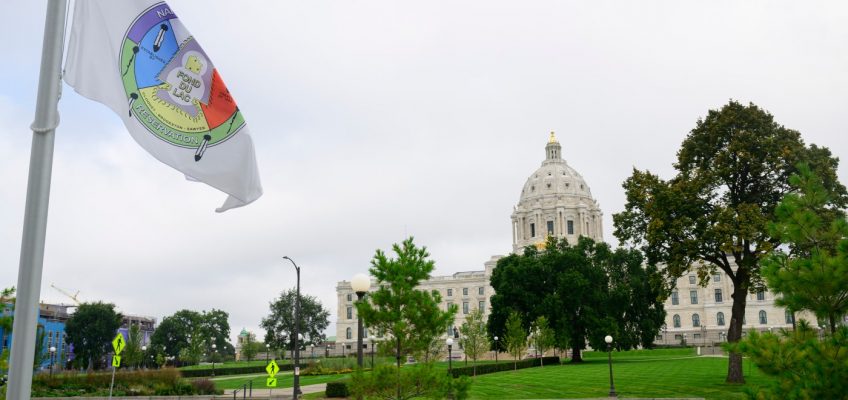A new addition at the state Capitol grounds is meant to highlight an important aspect of Minnesota’s past and present.
Eleven flags were raised earlier this month in front of the Capitol to recognize Native American tribes in the state. The Tribal Flag Plaza is intended to inform the public about their contributions.
Minnesota is the second state to have tribal flags at their capitol after Montana, reported MPR News.
Flags from Minnesota’s 11 Native American tribes fly over state Capitol grounds in St. Paul. Photographed on Thursday, Sept. 11, 2025. (John Autey / Pioneer Press)
The 11 flags represent the relationship between the state and the tribes. At the base of each flag are plants chosen by each tribe, each with cultural and ecological significance.
The initial idea came after Montana raised their tribes’ flags in 2020, according to Patina Park, the executive director of State Tribal Relations. Several of the tribes reached out to the Minnesota officials for a similar plaza, Park said.
The plaza design was approved by the Capitol Area and Architectural Planning Board in 2024. Construction started early this year and finished in September, according to Erik Cederleaf Dahl, the executive secretary for the Capitol Area and Architectural Planning Board.
At the grand opening on Sept. 5, Lt. Gov. Peggy Flanagan said the plaza is more than just a new landscape.
“The Capitol should tell the full story of the history of Minnesota, one that honors all 11 federally recognized tribal nations, acknowledges complex histories and builds a future rooted in inclusion, beauty and truth,” Flanagan said at the celebration.
The plaza is a part of the large Minnesota 2040 plan, a project to make the Capitol mall area more accessible to all residents.
Park said the flags show the progress between the state government and Native American tribes.
“I think it reflects the intentional partnership and relationship building we have been doing over the last six years, governor’s two terms,” Park said.
For Michael Child Jr., the Prairie Indian Community Tribal Council treasurer, the flags are a way to represent the contributions of the native community.
“The plaza to me, kind of reminds people of history, but also reminds people that we are still here. We’re not some historical long gone and forgotten people,” Child said.
Dahl said the next step for the plaza is signage at the bottom of each flag, explaining each tribe’s seal. The signs will have the tribe’s name in their native language and English, there will also be information about the tribe in English, according to Park.
Both Park and Dahl hope when people walk by they will want to stop near the flags and learn more.
“I hope it triggers people to have a curiosity, to want to learn more, maybe travel, visit the tribal lands and go to their cultural sites or their cultural buildings,” Park said.
Minnesota’s federally recognized tribes
The 11 federally recognized tribes are:
• Lower Sioux Indian Community.
• White Earth Nation.
• Leech Lake Band of Ojibwe.
• Grand Portage Band of Lake Superior Chippewa.
• Shakopee Mdewakanton Sioux Community.
• Mille Lacs Band of Ojibwe.
• Red Lake Nation.
• Fond du Lac Band of Lake Superior Chippewa.
• Upper Sioux Community.
• Prairie Island Indian Community.
• Bois Forte Band of Chippewa.
Related Articles
Prairie Island Indian Community welcomes home ancestral remains
North Dakota tribes denied in appeal of new district map


Leave a Reply